


The governing offices of medieval church and state – such as emperor, king, pope, archbishop, abbot, mayor, and so on – were often filled by election, in accordance with public and canon law. Often, election by a voting body facilitated the peaceful transference of power, even if such decisions also considered the privileges of birth and rank, as well as the requirements of the church.
Under canon law, medieval people were guaranteed certain human rights, including welfare rights, the right of certain classes to vote, and religious liberty (Helmholz 3). Canonists supported the free exercise of these rights, as they believed them to be supported by biblical tradition. Common law, or ius commune, upheld that a right order of government on earth was based in natural law and the upholding of these God-given rights. In effect, common law and canon law were seen as linked systems, to be enforced at the highest level to promote God’s plan for the world. Voting rights were recognized under both systems, so that secular elections evolved from the system put in place by medieval canonists for choosing offices within the church (Helmholz 6).
Medieval elections took place primarily in three contexts, ecclesiastical, secular and academic, but detailed evidence about them is scarce. Voting in both ecclesiastical and secular elections could follow one of four main procedures: overseen by an external authority with no direct interest in the election; by indirect election, in which electors named a proxy to select the officials; by lot; and by ballot (Uckelman and Uckelman 3). In contrast to most modern practice, electors had a limited choice, and the outcome of an election was always subject to the judgment of their superiors. Medieval law also ruled that all of the electors had to meet at the same time in the same place, whether or not the actual voting was done in secret. This was to mimic the meeting of the apostles at Pentecost and to wait for divine guidance before voting (Helmholz 8).
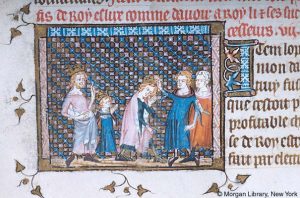
For some medieval rulers, the election, crowning, and anointing of Old Testament kings proved to be an excellent model for legitimizing their rule. Biblical tradition not only provided a justification for absolute reign, it also ensured that the church remained authoritative over secular rulers. In principle, the selection of a medieval monarch was based on both elective and hereditary elements, but from the tenth century in northern and central Europe, political and social trends steered toward hereditary succession over an elective monarchy (Nelson 183). This trend is exemplified in a French manuscript titled the Avis aus Roys, or royal advice book, dating to the mid-fourteenth century and possibly made for Louis, Duc d’Anjou (1339-1385). This book highlights the benefits of adhering to hereditary royal succession, which was widely seen as a more secure and manageable transference of power than other means of selecting a ruler.
The Church’s rules for filling ecclesiastical offices presented a paradox, as they strongly favored a mix of election and hierarchy. Before the papal bull In nomine Domini of 1059, which included an election decree, the pope’s successor was most often named by the incumbent pope or by secular rulers (Larson 151). Reforms put in place over the course of the twelfth and thirteenth centuries resulted in the creation of the first papal conclave (1276) and College of Cardinals, the familiar process for electing the pope that is still in practice today. Below the pope were elected cardinals, archbishops, bishops, and other local offices for priests and deacons. Episodes of their ritual consecration, ordination, vesting, installation, and taking orders feature prominently in the Index subject headings. Another elective office common in the Middle Ages was that of abbot or abbess of a monastery.
Among the more numerous depictions of Benedict of Montecassino delivering rule to monks is a rare episode in an Italian manuscript depicting him chosen as abbot. In this Vita Benedicti, dating to the mid-fifteenth century, a miniature depicts a group of monks presenting a letter, stamped with a dangling wax seal, to the new abbot-elect standing in the doorway of his mountain monastery.
The Index collection includes many images of election-related imagery, including depictions of medieval leadership, kingly coronations, ecclesiastical consecrations, synods, and deliberating monks. Typical subject headings include David: proclaimed King, Solomon: crowned King; Simon Thassi: chosen Leader of Machabees; Edmund of England: Scene, Coronation and Consecration; Guillaume de Machaut, Livre du Voir Dit: Scene, King addressing Court; and Louis of Toulouse: Scene, taking of Orders.
Sources
Benson, Robert L. The Bishop-Elect: A Study in Medieval Ecclesiastical Office. Princeton: Princeton University Press, 1968.
Barzel, Yoram, and Edgar Kiser. “The development and decline of medieval voting institutions: A comparison of England and France.” Economic Inquiry 35, no. 2 (1997): 244-60.
Uckelman, Sara L., and Joel Uckelman. “Strategy and manipulation in medieval elections.” Accessed in http://ccc.cs uni-duesseldorf. de/COMSOC2010/papers/logiccc-uckelman. pdf (2010), 1-12.
Helmholz, Richard H. “Fundamental Human Rights in Medieval Law.” (Fulton Lectures 2001): 1-18.
Nelson, Janet L. “Medieval Queenship.” In Women in Medieval Western European Culture, edited by Linda E. Mitchell, 179-208. New York and London: Routledge, 2011.
Weiler, Björn. “8 things you (probably) didn’t know about medieval elections.” History Extra Blog. N.p., 6 May 2015.
Larson, Atria. “Popes and Canon Law.” In A Companion to the Medieval Papacy: Growth of an Ideology and Institution, edited by Atria Larson and Keith Sisson, 135-37. Leiden: Brill, 2016.
 Our website has had a lot of new traffic since its launch, and some users have reported difficulties getting into the database from our homepage. Please remember that if you normally access the database through an institutional subscription, you may still need to enter through your library website, using your institutional credentials. If you encounter other kinds of access problems, please use the staff contacts to let us know. We are happy to help.
Our website has had a lot of new traffic since its launch, and some users have reported difficulties getting into the database from our homepage. Please remember that if you normally access the database through an institutional subscription, you may still need to enter through your library website, using your institutional credentials. If you encounter other kinds of access problems, please use the staff contacts to let us know. We are happy to help.
 The Index of Christian Art is pleased to invite applications for a one-year postdoctoral fellowship for AY 2017-2018, with the possibility of renewal contingent on satisfactory performance.
The Index of Christian Art is pleased to invite applications for a one-year postdoctoral fellowship for AY 2017-2018, with the possibility of renewal contingent on satisfactory performance.
Funded by a generous grant from the Kress Foundation, the Kress Postdoctoral Fellow will collaborate with permanent research and professional staff to develop taxonomic and research enhancements for the Index’s redesigned online application, which is set to launch in fall 2017. Salary is $60,000 plus benefits for a 12-month appointment, with a $2,500 allowance provided for scholarly travel and research. The Fellow will enjoy research privileges at Princeton Libraries as well as opportunities to participate in the scholarly life of the Index and the Department of Art & Archaeology.
The successful candidate will have a specialization in medieval art from any area or period; broad familiarity with medieval images and texts; a sound grasp of current trends in medieval studies scholarship; and a committed interest in the potential of digital resources to enrich work in art history and related fields. Strong foreign language and visual skills, the ability to work both independently and collaboratively after initial training, and a willingness to learn new technologies are highly desirable; previous experience in digital humanities, teaching, and/or library work is advantageous. Applicants must have completed all requirements for the PhD, including dissertation defense, before the start of the fellowship. Preference will be given to those whose subject expertise complements that of current Index staff.
Applications will be reviewed beginning January 15 and will continue until the position is filled. Applicants must apply on line at https://jobs.princeton.edu/applicants/jsp/shared/Welcome_css.jsp, submitting a C.V., a cover letter, a research statement, and the names and contact information of three references. The position is subject to the University’s background check policy.
Princeton University is an Equal Opportunity/Affirmative Action Employer, and all qualified applicants will receive consideration for employment without regard to age, race, color, religion, sex, sexual orientation, gender identity or expression, national origin, disability status, protected veteran status, or any other characteristic protected by law.
The Index is pleased to announce the speakers for two honorary sessions at the International Congress on Medieval Studies to be held at Western Michigan University (Kalamazoo, MI) on May 11-14, 2017.
Organized by Judith Golden and Jessica Savage, Index of Christian Art, Princeton University
Presider: Judith H. Oliver, Colgate University, Professor Emerita

This session will examine the interaction between words and images in medieval manuscripts as they shape the reader-viewer’s experience of the book. How do texts and images interact on the page? How did medieval readers respond to the varied discourses between images and texts? This session endeavors to open up new perspectives in describing, analyzing, and contextualizing manuscript illumination according to their intrinsic or peripheral textual elements. Papers in this session will undertake a close study of a particular manuscript and will expand upon theories for image-text composition by reviewing evidence of an artist’s written instructions; reading images with layered text additions, omissions or annotations; and recovering the reader’s experience through text and iconography.
“Artists and Autonomy: Written Instructions and Preliminary Drawings for the Illuminator in the Huntington Library Legenda aurea (HM 3027)”
“Bodies of Words: Text and Image in an Illustrated Anatomical Codex (Bodleian Library, MS Ashmole 399)”
“A Votive ‘Closing’ in the Claricia Psalter (Walters MS W.26)”
Presider: M. Alison Stones, University of Pittsburgh, Professor Emerita
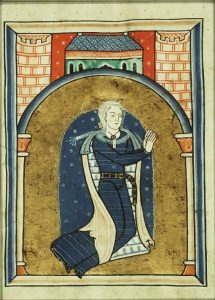
This session will examine the varied “visual signatures” of manuscript patrons, including dress, gestures, posture, and attributes of donor figures; heraldry and personalized inscriptions; marginal notes, colophons, dedications, and other signs of ownership and use in medieval manuscripts. Building on scholarship presented in the 2013 Index of Christian Art conference Patronage: Power and Agency in Medieval Art, this session will investigate the dynamic system of patronage centered on the interaction of owners with their books (whether as creator, patron, commissioner, or reader-viewer). Papers will address the importance of gender and social roles in book production, use, and readership, or will expand upon the role of patron as instigator in the book creation process, from payment to design.
“How Owner Portraits Work”
“The Patroness Portrait of the Fécamp Psalter (c. 1180): An Unknown Example of Royal Artistic Commission in Angevin Normandy”
“Patron Portrait as Creation Myth: On ‘Production Scenes’ in Illuminated Manuscripts”
In July 2016, Adelaide Bennett Hagens retired from the Index of Christian Art at Princeton University after fifty years of dedicated research and scholarship. She studied under Robert Branner at Columbia University and joined the Index during the directorship of Rosalie Green. Adelaide has studied medieval art in a variety of media, but her passion at the Index and in her personal research has always been manuscript illumination, particularly of the Gothic period. Her publications include “Some Perspectives on the Origins of Books of Hours in France in the Thirteenth Century,” in Books of Hours Reconsidered, edited by Sandra Hindman and James H. Marrow (2013); “Making Literate Lay Women Visible: Text and Image in French and Flemish Books of Hours, 1220–1320,” in Thresholds of Medieval Visual Culture: Liminal Spaces, edited by Elina Gertsman and Jill Stevenson (2012); and “The Windmill Psalter: The Historiated Letter E of Psalm One,” Journal of the Warburg and Courtauld Institutes 43 (1980). In two sessions, we celebrate Adelaide’s accomplishments and recognize her contributions to the Index of Christian Art and to the wider medieval and academic community.
It’s back to school time! Modern children enjoy the luxury of a school year that reflects an agrarian society, allowing time off during the summer months when all available hands were put to work in the fields. During the Middle Ages, many students lived, learned, and worked at home year round.
They learned how to be good citizens, and how to interact in society. They were taught basic Christian tenets and prayers. Boys learned a skill, following the family business, be it farming, blacksmithing, stone carving or brewing. Girls were taught how to run a household and the rudiments of the family business, to assist a future husband or possibly to take over business herself. In wealthier households, children learned similar life skills, but they had the advantage of becoming literate. A number of manuscripts exist that include the alphabet, Pater Noster, the credo, and familiar prayers as part of a book of hours. Under the guidance of parents, these books helped to form literate, religious offspring (Illus. 1).
Medieval art provides insights into the education of both boys and girls. Girls are shown at home, being individually tutored—as in the image of Agnes of Rome reading an open book before a seated tutor (Illus. 2)—or in small groups such as the one shown with the Virgin Mary and her mother (Illus. 3). Notably each of the girls has her own book, signaling a household of some wealth. Boys are shown at schools away from home. Jesus may be seen as a child carrying a paddle-shaped tablet with a panel of wax, slate, or parchment (Illus. 4). He is led by his mother, raising a scourge in her left hand—a view of the future, or merely an indicator of a boy who did not want to go to school? They walk toward an open-air building where the tutor holds an open book, showing the pages to several students. Other students study their own books, and several, including Jesus, wear what appear to be pen cases hanging from their belts. In another illustration, a single boy stands, perhaps reciting before the tutor, the rest of the class waiting their turns, some diligently studying open books, while one balances a book on his head (Illus. 5).
Not all were model students. Felix of Nola, whose story appears in the Golden Legend, is said to have been stabbed to death with styluses. The image here shows Felix lying on the floor of the school room, surrounded by students, one indeed holding a bloody stylus (Illus. 6). Aside from the goriness of the picture, it does give a sense of a school room. One basket, likely containing lunch, hangs on the wall while another is used as a weapon. A few books are visible, one open on a desk next to an inkpot and pen—likely a student’s blank book of either parchment or less expensive paper for recording lessons. One tablet is used as a weapon; another hangs on the wall. The same goes for satchels. A couple of students wear a pen case and ink pot on their belts; others hang on the wall.
Artists used marginal areas of a work of art to depict unusual ideas about a variety of topics, including education. A misbehaving monkey is whipped by his monkey tutor while two other monkeys look on, one with a sheet of paper or parchment on its lap (Illus. 7). A tutor holds withes in one hand and a tablet with the other while a grinning dog writes on the tablet, a stylus gripped in its right forepaw (Illus. 8). Above them are the letters ABC. Finally, a fox wearing a scholar’s cap, raising a baton with his right forepaw, teaches a flock of geese the art of singing. They all stand at a lectern with a book open perhaps to the text they are to sing (Illus. 9).
Illustrations:
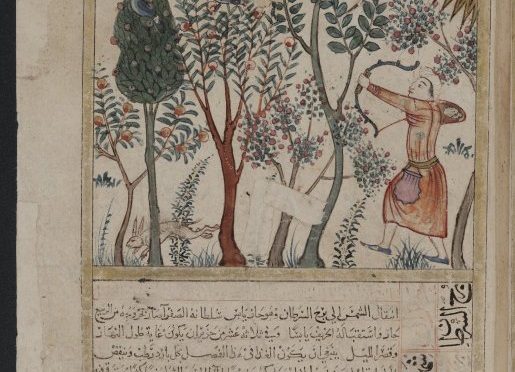
Observing the passing of time was central in medieval society, since climate had a profound effect on one’s livelihood and life habits. The turn of the seasons brought changes in diet, hygiene, mood, and activity, which were detailed and collected in a genre of late medieval health handbook known as Tacuinum Sanitatis (“The Maintenance of Health”). These show that, in preparing treatments, doctors took the time of the year, month and even day into account, along with six ‘non-natural’ factors—air, food and drink, motion and rest, sleep and waking, secretion and excretion, and mental state—as well as bathing (Jones 119; 133). Such factors are reflected in the Psalter of Lambert le Bèque, which includes twelve medallions forming a health calendar with rules and advice for each month and an image of a doctor with his assistants at the bottom of the page.
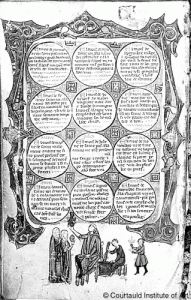
While elements of the illustrations were drawn from classical tradition, the medical recommendations and notion of time in the Tacuinum Sanitatis were heavily influenced by similar health handbooks in Arabic, the lingua franca of the Islamic world. The Tacuinum Sanitatis was based on an Arabic text written by Ibn Butlan, an eleventh-century Christian physician from Baghdad, who is credited as a source in manuscripts from Vienna, Paris, Casanatense, and Liège. His work was so respected by European translators that they even copied out mistakes made by previous Arabic copyists without change. Its translation into Latin in southern Italy or Sicily helped to disseminate it across Europe (Arano 8–11). The work’s Arabic origins are reflected in the title Tacuinum, which comes from the Arabic taqwim, meaning “table” and referring to the table-like organization of health handbooks in the Arabic tradition, a configuration possibly referenced in the square shape of the illustrations in the Tacuinum Sanitatis.

A sense of the Arabic source for the Tacuinum Sanitatis can be found in the Kitab al-Bulhān, a fifteenth-century miscellany in Arabic, now in the Bodleian Library in Oxford (MS. Bodl. Or. 133). The Bodleian manuscript compiled various astrological, astronomical, and divinatory texts. Notably, in its tale for the four seasons, it advised the following diet for the summer months:
“Food should be reduced and drink somewhat increased. Drinks must be well mixed with cold water and snow. Warm, dry medicines and foods must be avoided. Only delicate meat is to be eaten, such as that of black lamb (al-humldn al-suid). There is no harm in eating beef and goat’s meat if prepared with vinegar and celery (karafs). One should not linger in the bath nor should emetics be resorted to frequently.” (Arano color plate XII).
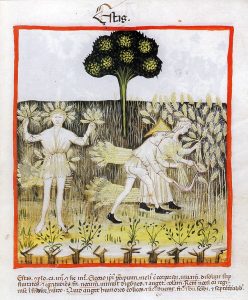
Similar instructions for a humid diet and delicate foods that can be easily digested also appear in a fourteenth-century Latin manuscript of the Tacuinum Sanitatis, written in Lombardy and held in the Österreichische Nationalbibliothek (Cod. Vindob. ser. nov. 2644, fol. 54r). This manuscript states that when nature is “warm in the third degree, dry in the second” the body is at its optimum health to beat “superfluities and cold diseases.”(Arano color plate XII). Yet the summer months were not without their health afflictions, like sluggish digestion or an increase in bilious humors. The Vienna Tacuinum codex suggests taking in a “humid diet” in a “cool environment” to overcome these disagreeable humors. The handbook states that a continuation of the diet works in “cold temperaments, for old people, and in Northern regions.” (Arano color plate XII).

The accompanying image of a youth wearing a crown of grain and holding a sprig is strikingly similar to depictions of the labors of the month and the personification of summer.
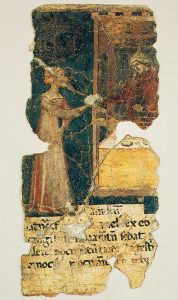
This imagery found its way into other media recorded by the Index, such as a Veronese fresco fragment in the Museo Civico di Castelvecchio in Verona. Dated to the last quarter of the fourteenth century, this fresco contains three scenes from the Tacuinum Sanitas. Fragments from the Palazzo dei Tribunali in Verona depict occupational scenes of cooking and commerce that address the inclusion of starch and dill in the diet.
Interestingly, once the Tacuinum text became popular in Europe, Italian innovations began making their way back into Arabic manuscripts. The illumination in the Lombardy manuscript was also influential in the development of contemporary landscape painting, focusing on the changes in nature itself, as well as human responses to them. This influence is perceptible in the Bodleian manuscript, made approximately a decade after the Italian manuscript. The illumination of seasons and cycles here shows a distinctly European approach with Arabic elements worked in. These details include turbaned figures in rich pastoral landscapes dotted with European architecture, a hunter’s long, pointed shoes, a half-length traditional gown, a belted pouch and a goblet of wine in the Autumn scene. And so the artist of the Bodleian Kitab al-Bulhān blended elements of both cultures with innovations of his own, according to his taste.
The Index catalogs many images of seasonal and medical imagery, including “Scene, Occupational: Doctoring” (60+ work of art records) and “Scene, Occupational: Cooking” (70+ work of art records).
Sources:
Ann Henisch, Bridget. The Medieval Calendar Year. (University Park, PA: Penn State University Press, 1999)
Carson Webster, James.The Labors of the Months in Antique and Medieval Art to the End of the Twelfth Century. (Princeton: Princeton University Press, 1938)
Cogliati Arano, Luisa. Medieval Health Handbook: Tacuinum Sanitatis. (New York: George Brazilier, 1976)
Hourihane, Colum, ed. Time in the Medieval World: Occupations of the Months and Signs of the Zodiac in the Index of Christian Art. (Pennsylvania: Penn State University Press, 2007)
Murray Jones, Peter. Medieval Medical Manuscripts. (Austin: University of Texas Press, 1984)
Rice, D. S. ‘The Seasons and the Labors of the Months in Islamic Art’. Ars Orientalis 1 (1954): 1-39. http://www.jstor.org/stable/pdf/4628981.pdf
This guest blog post was written by Rachel Dutaud, a summer student assistant at the Index of Christian Art and a fourth year art history student at the University of St. Andrews. Rachel is completing her undergraduate dissertation on the portraiture of Hatshepsut, Olympias of Macedonia, and Theodora. Her interests are in Early Christian and Byzantine art, classicism, iconography, and archives.
The Index of Christian Art is sponsoring two sessions in honor of Adelaide Bennett Hagens at the 52nd International Congress on Medieval Studies, University of Western Michigan, Kalamazoo, MI, May 11-14, 2017.

Image & Meaning in Medieval Manuscripts: Sessions in Honor of Adelaide Bennett Hagens
Session I: Text-Image Dynamics in Medieval Manuscripts
Session II: Signs of Patronage in Medieval Manuscripts
Organizers: Judith Golden and Jessica Savage, Index of Christian Art, Princeton University
Please see the full call for papers on our website here: https://ima.princeton.edu/conferences/
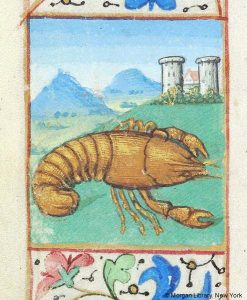
On June 21st we recognize Cancer, the astrological sign that Richard Hinckley Allen called the most “inconspicuous figure of the zodiac” (Allen, 107). Representing the sun at its highest point, Cancer is the zodiacal sign of the summer solstice. In ancient Egypt, the Cancer sign was imagined as a scarab beetle, and in Mesopotamia as a turtle or tortoise, both of which may have pushed the sun across the heavens. In Europe, traditionally, the constellation of Cancer was identified with the crab from Greek mythology that was crushed by the foot of Hercules and placed in the sky by Hera. Some have speculated that the characteristic sideways walk of hard-shelled crustaceans, whether crayfish or crab, could be symbolic of the backward shift in day-length after the arrival of the summer constellation in the Northern Hemisphere at the end of June, and Medieval people also believed those born under Cancer’s influence harnessed great, gripping power.
At the Index of Christian Art, the label “lobster-like” has been used to describe Cancerian crabs that are not at all “crab-like.” These crustaceans have elongated pincers, chunky claws, and a distinct tail, and they more closely resemble a lobster or a crayfish. The zoological treatise The Crustacea, published by Brill in 2004, states that, although crabs are the most frequent symbol of the Cancer sign, that the variety of shellfish that adorn horoscopes “can bring surprises” (Forest et al., 173). It is possible that while the symbol of Cancer may draw from a singular iconographic entity which included all shellfish, the idea of a distinct crab, including its spoken and written labels, could be historically transmutable. A definitive explanation for the choice of crustacean in horoscopes might be impossible, but there are some hints as to why “lobster-like” crabs were so pervasive in zodiacal art of the medieval period.
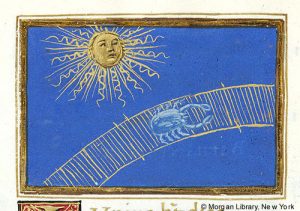
“Cancer,” “Crab,” & “Crayfish”
“Cancer” is an ancient word of Indo-European origin from a root meaning “to scratch.” Today Cancer is the scientific Latin genus name for “crab,” but in classical usage it described many species of shellfish. J.-Ö. Swahn notes in “The Cultural History of Crayfish” that in both Sanskrit and Greek the word for crab had the same meaning as crayfish, both animals having pincers. While the Latin word for Cancer, Carcinus, comes from the Greek karkinos, the English word “crab” has Germanic and Old English roots, and an Anglo-Saxon chronicle from about the year 1000 identified Cancer as crabba (Allen 107). In Old High German (800-1050), kerbiz meant simply “edible crustacean” and was also used to describe crayfish. The OED links the Middle High German (1050-1350) krebz to the Middle French (ca. 1400-1600) escrevisse, which in turn became écrevisse (crayfish).
The OED cites these words for crayfish, through much of their history, were general terms for all larger edible crustaceans. On “lobster,” OED notes some crayfish are called “fresh-water lobsters” and the term “lobster” is applied to several crustaceans of resemblance. Well into the seventeenth century, the word “cancer” and its translations were used as generic terms for all crabs and “lobster-like” creatures until Linnaeus established the species name Astacus Astacus for crayfish in his Systema Naturae of 1758 (interestingly, also with the synonym Cancer Astacus). The OED also noting that the 1656 translation of Comenius’ Latinae Linguae Janua Reserata, described the crayfish as a “shelled swimmer, with ten feet, and two claws: among which are huge Lobsters of three cubits; round Crabs; Craw-fish, little Lobsters.” So, etymologically speaking, crabs, crayfishes, and lobsters were mingled together from very early on.

Star Sign and Sustenance
In the Middle Ages, the zodiacal symbol of Cancer often appeared in the calendar pages of devotional books, or on adorned monumental sculpture of the Middle Ages. The Index records examples in these mediums (including examples on more than 200 manuscript pages) with the subject heading Zodiac Sign: Cancer. Generally, the depiction of the sign of Cancer as a crab is most prevalent in art from the Mediterranean and Western Europe, possibly due to the proximity to the sea, but the crayfish as a symbol for Cancer is not unusual, even in coastal regions. Crabs are saltwater decapods, creatures with ten feet or five pairs of legs. Crayfish are also decapods, but they thrive in freshwater lakes and rivers. Summer was the best season for fishing, and crayfish were easily trapped along the streams and creeks of rural Europe. The French and the English were the first to incorporate crayfish into their diet.
The Romans had viewed the crayfish as a scavenger animal, and they disliked the taste in their cuisine. Elevated from its lowly status as mere fodder in the classical era, crayfish came to be considered a delicacy in Western Europe from as early as the tenth century. In medicine, the sign ruled over the chest, stomach and ribs, and there are also several medieval pharmacological texts that note the medical properties of the crayfish, including the fact that “If you boil them in milk they cause a good sleep” (Swahn, “The Cultural History of Crayfish,” 247). We know that Europeans were using crayfish in their recipes and tinctures, so their distinctive form would have been a familiar one.
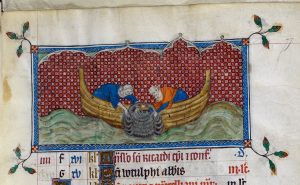
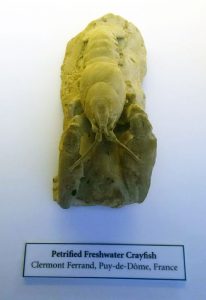
Sources
Allen, Richard Hinckley, Star-names and Their Meanings (New York, Leipzig: G.E. Stechert, 1899), 107-111.
Fischof, Iris, “The Twelve Signs,” in Written in the Stars: Art and Symbolism of the Zodiac (Jerusalem: Israel Museum, 2001), 111.
Forest, Jacques, J. C. von Vaupel Klein, and J. Chaigneau, The Crustacea: Treatise on zoology – anatomy, taxonomy, biology: Revised and updated from the Traité de zoologie (Leiden: Brill, 2004), 173.
Larkin, Deirdre, “Making Hay: The Zodiacal Sign of Cancer,” The Metropolitan Museum of Art Blog, June 5, 2009, http://blog.metmuseum.org/cloistersgardens/2009/06/05/making-hay/060509_bottom/
Swahn, J.-Ö, “The Cultural History of Crayfish,” Bulletin Français de la Pêche et de la Pisciculture 372-373 (2004): 243-251.
Oxford English Dictionary, s.v. “Cancer,” “Crab,” “Crayfish,” “Lobster,” accessed June 2016, http://www.oed.com/.
“Summer and Crayfish,” The Medieval Histories Blog, June 15, 2016, http://www.medievalhistories.com/summer-and-crayfish/.
The Index of Christian Art presents three images in honor of the 160,000 allied troops who landed on the fortified beaches of Normandy on 6 June 1944. The first, a detail of the Bayeux Embroidery portraying Duke William of Normandy sailing to England, evokes the seaborne operation that marked the beginning of the liberation of occupied Europe from Nazi control. The second, a sculpted personification of Fortitude holding a sword and shield from the west façade of Notre-Dame of Paris, speaks to the courage and resilience of the allied forces in the face of the enemy. The third, Ambrogio Lorenzetti’s languid depiction of Peace from the Allegory of Good Government fresco in the Palazzo Pubblico in Siena, alludes to the aftermath of the war, while also expressing hope for the resolution of current conflicts worldwide.
Mother’s Day has been celebrated annually in the United States on the second Sunday in May for over one hundred years. Following its declaration as an official holiday by the state of West Virginia, Woodrow Wilson issued a proclamation announcing the first national Mother’s Day on 9 May 1914.
Images of the Virgin and Child are among the most common depictions of motherhood from the Middle Ages. The Strahov Madonna of ca. 1340 captures the dynamism (or “squirminess”) typical of small children, while also communicating to beholders the special status of the figures through solemn expressions and meaningful gestures. The Child grasps his mother’s veil with his left hand and holds a goldfinch in his right hand, a pose adapted from the Virgin Kykkotissa, a highly venerated, miracle-working Byzantine icon thought to have been painted from life by Saint Luke. Portrayals of the Visitation present an earlier stage of motherhood.
A fifteenth-century French Book of Hours shows the pregnant Virgin gently cradling her swollen abdomen as she greets her cousin Elizabeth, pregnant with John the Baptist, who “leaped in her womb” (Luke 1:41). A thirteenth-century fresco of the birth of John the Baptist from Parma Baptistery captures yet another aspect of motherhood, depicting two midwives tending to Elizabeth as two others bathe her newborn infant.
The Index of Christian Art has 29 subject records for the Virgin Mary and Christ Child. John the Baptist: Birth appears in 104 records.